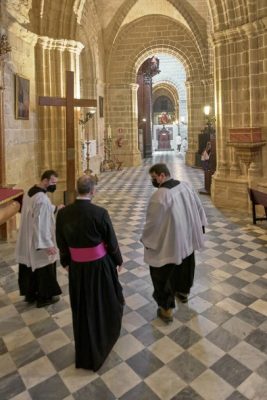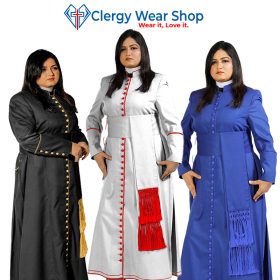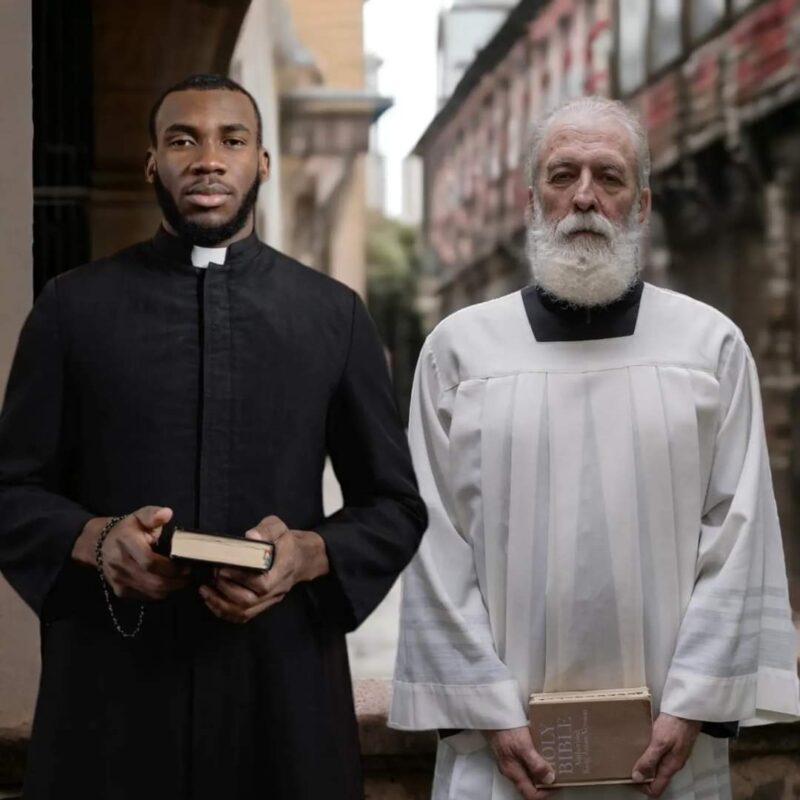Clergy Robes for Men
Understanding the Difference Between a Cassock and Surplice
Cassock vs Surplice Differences and When to Wear Each
Have you ever wondered why priests and ministers wear special clothes during church services? If you’ve felt unsure about the difference between a cassock and a surplice, you’re not alone. These two important garments have a lot of history and meaning, but people often mix them up or don’t know why they’re used differently.
In many Christian churches, the clothing worn by church leaders not only shows their role but also shares the traditions of the church. Going back hundreds of years, each have their own purpose in church services. But with so much history behind these garments, it can be hard to know when to wear each one, especially for people new to church.
Learning about what makes the cassock and surplice special can help us better understand religious practices. These clothes
are more than just fabric they carry years of history, tradition, and faith.
In this article, we’ll look at what these two special garments mean, how they’re different, and the ways they’re used in church today. Join us as we explore the meaning behind these important church garments!
What is a Cassock?
The cassock is a long, ankle-length robe worn by clergy members. It has a rich history dating back to medieval Europe, when it was first worn by both lay and ecclesiastical figures. Over time, the cassock became a distinctive garment for clergy, especially in Catholic, Anglican, and Orthodox traditions.
Design and Symbolism of the Cassock
Typically made of dark-colored fabric, most commonly black, the cassock features a straight-cut design that reaches the ankles. It is often buttoned or zipped at the front for ease of wear. The color of the cassock may change with the liturgical season, such as purple or red for special occasions like Advent or Pentecost.
The cassock symbolises humility, penance, and the clerical commitment to a life of service. Its practical design allows for ease of movement during religious services, while its dark color reinforces the solemnity of the priesthood.
What is a Surplice?
The surplice is an outer garment worn over the cassock during specific liturgical services. It is traditionally white and loose-fitting, symbolizing purity and light, which contrasts with the darker and more sombre tone of the cassock.
Design and Symbolism of the Surplice
The surplice typically falls to the knee or ankle and features wide, flowing sleeves. It is often decorated with lace or fine linen trim, which enhances its ceremonial appeal. The white color of the surplice signifies purity and spiritual clarity, and its flowing design adds an element of grace during sacred rituals.
In the Catholic tradition, the surplice is often worn with a stole a long, narrow strip of cloth draped around the neck, symbolizing the priest’s authority and role in the liturgy.
The Cassock, Surplice, and Stole: Worn Together

While the cassock is a more everyday garment, the surplice and stole elevate the attire for specific religious ceremonies. When these are worn together, they form a complete liturgical ensemble. The surplice’s white color and flowing design complement the black cassock, creating a balanced and respectful appearance.
Cassock, Surplice, and Tippet
In some traditions, such as the Anglican Church, the cassock, surplice, and tippet a scarf like piece of cloth are worn together. The tippet adds a layer of formality and is often worn by clergy during special services.
A Comparison in Cassock, Surplice and Alb
Both are distinct from the alb, another clerical garment. The alb is a simpler, more streamlined garment that covers the entire body and is often worn during baptisms, weddings, and sacraments. Unlike the cassock, the alb is typically white, and it is worn alone or over the cassock in some liturgies.
When to Wear a Cassock & Surplice
The cassock is typically worn as a foundational garment for religious ceremonies. It is often paired with the surplice during Mass, weddings, baptisms, and other significant liturgical events.
In the Catholic and Anglican traditions, the cassock is seen as the everyday attire of the clergy, setting the stage for more elaborate vestments like the surplice.The cassock and surplice ensemble is worn during specific liturgical events that require formal attire. This includes:
- Mass: The cassock and surplice are worn by priests during the Catholic Mass.
- Weddings and Baptisms: Clergy members often wear the cassock and surplice for sacraments.
- Choir Services: The surplice is commonly worn by choir members in both Catholic and Anglican churches.
Common Variations of Cassocks & Surplices
- White Cassock and Surplice:
Some clergy, especially in warmer climates, may wear a white cassock and surplice combination, which is less formal but still carries the significance of the full liturgical ensemble.
- Roman Cassock and Surplice:
In the Roman Catholic tradition, the cassock ensemble is often paired with a stole or other liturgical accessories. The Roman cassock may vary slightly in design and color based on the priest’s rank or occasion.
Cassock and Surplice Pattern
The pattern or design of the cassock and surplice can vary depending on the denomination or the specific liturgical function. For example, in some traditions, the cassock may be adorned with colored trim, or the surplice may feature intricate lace details.
FAQs
What is the purpose of a cassock and surplice?
These are worn by clergy as part of their liturgical attire. Together, they represent the clergy’s commitment to their vocation, adding formality and dignity to religious ceremonies.
Can laypersons wear a cassock and surplice?
Traditionally, the both are worn by clergy members. However, in some academic or ceremonial settings, non-clergy may wear these garments.
When should a priest wear a cassock and surplice?
A cassock and surplice are typically worn during Catholic Mass, weddings, baptisms, and other significant liturgical events. The specific occasion often dictates whether these garments are required.
What are the differences between cassock and surplice in Catholic and Anglican traditions?
While both traditions use attire, there may be slight variations in fabric, fit, and ornamentation, reflecting the different practices and ceremonial requirements of each denomination.
Can women wear cassocks and surplices?
Yes, in many Catholic and Anglican communities, women clergy may wear the cassock and surplice ensemble, especially in denominations that ordain female clergy.
Conclusion:
Whether you’re seeking a set for a special occasion or looking to refresh your clergy wardrobe, Clergy Wear Shop offers high-quality vestments that combine tradition, comfort, and style.
Explore our collection of cassocks, surplices, and other liturgical garments to find the perfect ensemble for your sacred duties.

 Clergy Cassocks for Men
Clergy Cassocks for Men Clergy Cassocks for Women
Clergy Cassocks for Women Clergy Robes for Women
Clergy Robes for Women Clergy Shirts for Men
Clergy Shirts for Men Clergy Shirts for Women
Clergy Shirts for Women